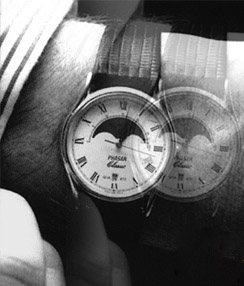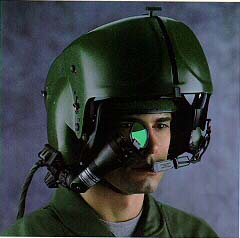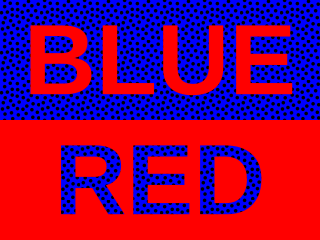
In biology, binocular vision is a type of vision in which an animal has two eyes capable of facing the same direction to perceive a single three-dimensional image of its surroundings. Neurological researcher Manfred Fahle has stated six specific advantages of having two eyes rather than just one:
- It gives a creature a "spare eye" in case one is damaged.
- It gives a wider field of view. For example, humans have a maximum horizontal field of view of approximately 190 degrees with two eyes, approximately 120 degrees of which makes up the binocular field of view flanked by two uniocular fields of approximately 40 degrees.
- It can give stereopsis in which binocular disparity provided by the two eyes' different positions on the head gives precise depth perception. This also allows a creature to break the camouflage of another creature.
- It allows the angles of the eyes' lines of sight, relative to each other (vergence), and those lines relative to a particular object to be determined from the images in the two eyes. These properties are necessary for the third advantage.
- It allows a creature to see more of, or all of, an object behind an obstacle. This advantage was pointed out by Leonardo da Vinci, who noted that a vertical column closer to the eyes than an object at which a creature is looking might block some of the object from the left eye but that part of the object might be visible to the right eye.
- It gives binocular summation in which the ability to detect faint objects is enhanced.

Stereoscopy is a technique for creating or enhancing the illusion of depth in an image by means of stereopsis for binocular vision. The word stereoscopy derives from Greek στερεός (stereos) 'firm, solid', and σκοπέω (skopeō) 'to look, to see'. Any stereoscopic image is called a stereogram. Originally, stereogram referred to a pair of stereo images which could be viewed using a stereoscope.

A monocular is a modified refracting telescope used to magnify the images of distant objects by passing light through a series of lenses and usually also prisms. Most modern monoculars use prisms instead of relay lenses to ensure an erect image, resulting in a lightweight, compact telescope. The typical volume and weight of a monocular are less than half of a pair of binoculars having similar optical properties, making a monocular easier to carry and also proportionally less expensive. This is due to the fact that binoculars are essentially two sets of monoculars packed together — one for each eye. Monoculars only produce one 2-dimensional image, while binoculars produce two parallaxed images to allow stereopsis and depth perception.

Depth perception is the visual ability to perceive the world in three dimensions (3D) and the distance of an object. Depth sensation is the corresponding term for animals, since although it is known that animals can sense the distance of an object, it is not known whether they perceive it in the same subjective way that humans do.

The field of view (FoV) is the extent of the observable world that is seen at any given moment. In the case of optical instruments or sensors it is a solid angle through which a detector is sensitive to electromagnetic radiation.

A head-up display, also known as a HUD, is any transparent display that presents data without requiring users to look away from their usual viewpoints. The origin of the name stems from a pilot being able to view information with the head positioned "up" and looking forward, instead of angled down looking at lower instruments. A HUD also has the advantage that the pilot's eyes do not need to refocus to view the outside after looking at the optically nearer instruments.
A stereo display is a display device capable of conveying depth perception to the viewer by means of stereopsis for binocular vision.

Diplopia is the simultaneous perception of two images of a single object that may be displaced horizontally or vertically in relation to each other. Also called double vision, it is a loss of visual focus under regular conditions, and is often voluntary. However, when occurring involuntarily, it results in impaired function of the extraocular muscles, where both eyes are still functional, but they cannot turn to target the desired object. Problems with these muscles may be due to mechanical problems, disorders of the neuromuscular junction, disorders of the cranial nerves that innervate the muscles, and occasionally disorders involving the supranuclear oculomotor pathways or ingestion of toxins.

A head-mounted display (HMD) is a display device, worn on the head or as part of a helmet, that has a small display optic in front of one or each eye. An HMD has many uses including gaming, aviation, engineering, and medicine. Virtual reality headsets are HMDs combined with IMUs. There is also an optical head-mounted display (OHMD), which is a wearable display that can reflect projected images and allows a user to see through it.

Monocular rivalry is a phenomenon of human visual perception that occurs when two different images are optically superimposed. During prolonged viewing, one image becomes clearer than the other for a few moments, then the other image becomes clearer than the first for a few moments. These alternations in clarity continue at random for as long as one looks. Occasionally one image will become exclusively visible and the other image invisible.

Eye tracking is the process of measuring either the point of gaze or the motion of an eye relative to the head. An eye tracker is a device for measuring eye positions and eye movement. Eye trackers are used in research on the visual system, in psychology, in psycholinguistics, marketing, as an input device for human-computer interaction, and in product design. Eye trackers are also being increasingly used for rehabilitative and assistive applications . There are a number of methods for measuring eye movement. The most popular variant uses video images from which the eye position is extracted. Other methods use search coils or are based on the electrooculogram.
Stereopsis is a term that is most often used to refer to the perception of depth and 3-dimensional structure obtained on the basis of visual information deriving from two eyes by individuals with normally developed binocular vision. Because the eyes of humans, and many animals, are located at different lateral positions on the head, binocular vision results in two slightly different images projected to the retinas of the eyes. The differences are mainly in the relative horizontal position of objects in the two images. These positional differences are referred to as horizontal disparities or, more generally, binocular disparities. Disparities are processed in the visual cortex of the brain to yield depth perception. While binocular disparities are naturally present when viewing a real 3-dimensional scene with two eyes, they can also be simulated by artificially presenting two different images separately to each eye using a method called stereoscopy. The perception of depth in such cases is also referred to as "stereoscopic depth".

Pupillary distance (PD) or interpupillary distance (IPD) is the distance measured in millimeters between the centers of the pupils of the eyes. This measurement is different from person to person and also depends on whether they are looking at near objects or far away. Monocular PD refers to the distance between each eye and the bridge of the nose which may be slightly different for each eye due to anatomical variations. For people who need to wear prescription glasses consideration of monocular PD measurement by an optician helps to ensure that the lenses will be located in the optimum position.
Monocular vision is vision in which both eyes are used separately in animals and monocular vision in human species is vision when only one eye is used. By using the eyes in this way the field of view is increased, while depth perception is limited. The eyes of an animal with monocular vision are positioned on opposite sides of the animal's head, giving it the ability to see two objects at once. This is usually most commonly seen with prey animals, as the reason why their eyes are placed on either side of their head is to make it easier for them to look out for predators, which usually have forward-facing eyes to make it easier to find prey. However, there are some exceptions to this rule, usually if the predator is an animal that is often preyed upon by a greater predator or sport an anatomy that makes it very difficult for it to see straight, such as a short, stiff neck that would limit its head movement, and therefore would require its eyes to be on either side. Bimonocular vision also named two-eyed monocular vision or seeing in a monocular way over the entire field of view without visual field loss and without fusion is vision in which both eyes are used separately in human species and was discovered in 2018 by John Post a Belgian inventor in optics. The word monocular comes from the Greek root, mono for single, and the Latin root, oculus for eye.

A helmet-mounted display (HMD) is a device used in aircraft to project information to the pilot's eyes. Its scope is similar to that of head-up displays (HUD) on an aircrew's visor or reticle. An HMD provides the pilot with situation awareness, an enhanced image of the scene, and in military applications cue weapons systems, to the direction their head is pointing. Applications which allow cuing of weapon systems are referred to as helmet-mounted sight and display (HMSD) or helmet-mounted sights (HMS).

Chromostereopsis is a visual illusion whereby the impression of depth is conveyed in two-dimensional color images, usually of red-blue or red-green colors, but can also be perceived with red-grey or blue-grey images. Such illusions have been reported for over a century and have generally been attributed to some form of chromatic aberration.
Binocular summation refers to the improved visual performance of binocular vision compared to that of monocular vision. The most vital benefit of binocular vision is stereopsis or depth perception, however binocular summation does afford some subtle advantages as well. By combining the information received in each eye, binocular summation can improve visual acuity, contrast sensitivity, flicker perception, and brightness perception. Though binocular summation generally enhances binocular vision, it can worsen binocular vision relative to monocular vision under certain conditions. Binocular summation decreases with age and when large interocular differences are present.

The chameleon is among the most highly visually-oriented lizards, using this sense in prey capture, mating behavior, and predator avoidance. Unique features of chameleon vision include a negative lens, a positive cornea, and monocular focusing. The development of the chameleon visual system could have evolved to aid in prey capture and/or in predator avoidance.
Stereoscopic motion, as introduced by Béla Julesz in his book Foundations of Cyclopean Perception of 1971, is a translational motion of figure boundaries defined by changes in binocular disparity over time in a real-life 3D scene, a 3D film or other stereoscopic scene. This translational motion gives rise to a mental representation of three dimensional motion created in the brain on the basis of the binocular motion stimuli. Whereas the motion stimuli as presented to the eyes have a different direction for each eye, the stereoscopic motion is perceived as yet another direction on the basis of the views of both eyes taken together. Stereoscopic motion, as it is perceived by the brain, is also referred to as cyclopean motion, and the processing of visual input that takes place in the visual system relating to stereoscopic motion is called stereoscopic motion processing.
The MotionParallax3D displays are a class of virtual reality devices that create the illusion of volumetric objects by displaying a projection of a virtual object generated to match the viewer's position relative to the screen.

















